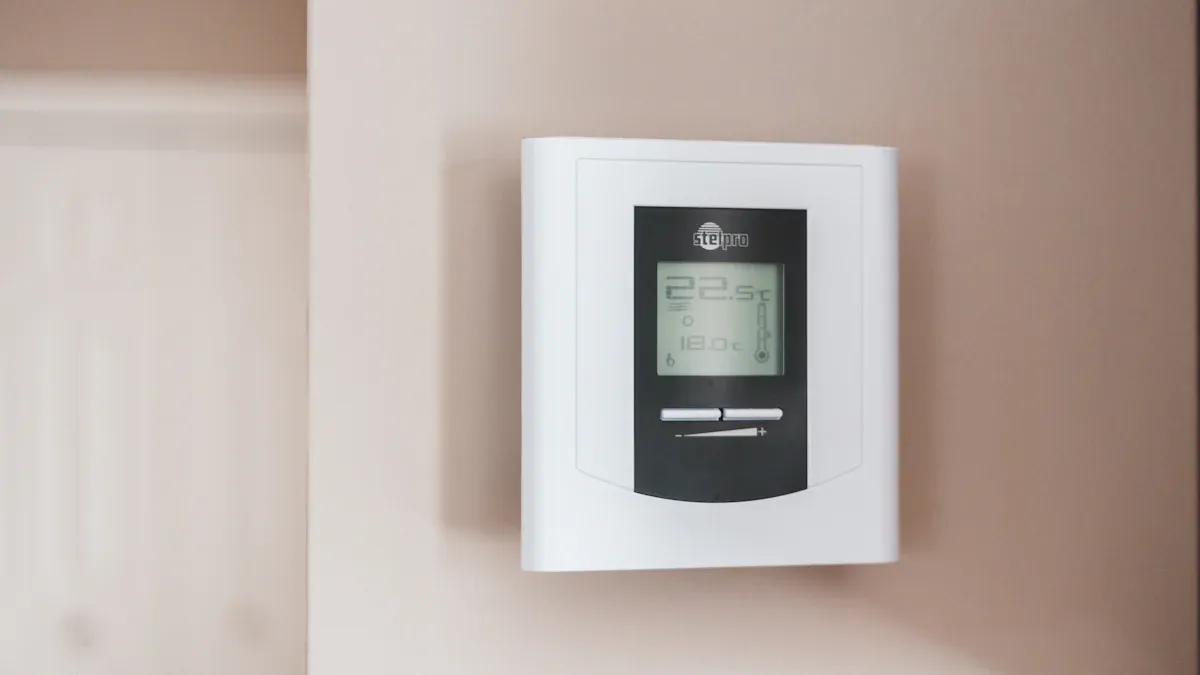
Outdoor security systems demand reliable power. You need a battery that can withstand every temperature challenge. Extreme temperature swings—ranging from -40°C to +60°C—directly affect battery life, battery safety, battery charge retention, and battery performance. If you deploy sensors in these conditions, temperature impacts battery chemistry, battery voltage, and battery cycle life. Battery failures from temperature extremes cause costly downtime. A Wide-Temperature Range lithium-ion battery with a robust operating temperature ensures your devices keep running, no matter the temperature. Temperature control, temperature resilience, and temperature stability define your battery solution. Temperature management, temperature protection, and temperature adaptability all play critical roles in battery longevity. How do you develop a battery that delivers consistent performance when temperature becomes the biggest threat?
Key Takeaways
Choose lithium-ion batteries designed for extreme temperatures to ensure reliable performance in outdoor security systems.
Implement proper installation practices, such as using weatherproof enclosures and avoiding direct sunlight, to extend battery life and maintain optimal performance.
Regularly monitor and maintain batteries by checking for damage, keeping them within optimal temperature ranges, and following manufacturer guidelines to enhance safety and efficiency.
Part 1: Temperature Challenges

1.1 Battery Performance in Extreme Temperature
You face significant challenges when deploying lithium-ion batteries in environments with temperature extremes. At -40°C, the electrolyte inside the battery can solidify, which increases internal resistance and causes capacity to drop to as low as 10%-20% of normal. In these conditions, lithium-ion cells may retain only 57% of their capacity compared to room temperature. High temperatures above 60°C accelerate electrolyte decomposition, which can trigger thermal runaway and even explosions due to increased internal pressure and the collapse of the solid electrolyte interface (SEI). Prolonged exposure to high temperatures also accelerates battery aging, increases internal resistance, and reduces both capacity and cycle life.
At low temperatures:
Electrolyte solidifies, raising resistance.
Capacity drops sharply.
Charging can cause lithium plating, increasing safety risks.
At high temperatures:
Electrolyte decomposes, risking thermal runaway.
SEI layer collapses, reducing battery performance.
Long-term exposure between 45–60°C can cut battery lifespan by up to 40%.
You must select lithium-ion batteries engineered for high temperature stability and cold weather performance to ensure reliable operation in outdoor security cameras and sensors.
1.2 Effects on Outdoor Security Cameras
Outdoor security cameras rely on stable battery performance to deliver uninterrupted surveillance. Extreme temperatures can cause voltage control problems, leading to malfunctions or shutdowns. Lithium-ion batteries maintain stable voltage and performance during temperature fluctuations, which is crucial for advanced camera features and reliable operation. In contrast, alkaline batteries often suffer from voltage drops, resulting in system failures.
Tip: Install cameras in shaded or ventilated areas and avoid direct sunlight to protect battery packs from overheating.
Common battery failure modes in outdoor security cameras include swelling, deformation, and rapid capacity loss. Charging lithium-ion batteries in cold conditions can lead to lithium plating, which increases the risk of short-circuiting. High temperatures erode battery capacity and increase the risk of thermal runaway, especially above 60°C. You should regularly check battery voltage and look for signs of overheating to mitigate safety risks.
Temperature resilience remains essential for outdoor security cameras and sensors. By choosing lithium-ion batteries designed for the optimal temperature range, you ensure consistent performance and minimize downtime in your security system battery solution.
Part 2: Wide-Temperature Range Lithium-Ion Batteries

2.1 Advanced Chemistry and Cell Design
You need lithium-ion batteries engineered for wide-temperature range operation to ensure reliable power in outdoor environments. Material selection and cell construction play a critical role in battery efficiency, battery capacity, and battery longevity. Advanced lithium chemistries, such as South 8’s LiGas and lithium metal, deliver proven performance from -40°C to +60°C and beyond. These chemistries suppress lithium dendrite formation and improve cycling performance at elevated temperatures, which is essential for outdoor security systems, infrastructure, and industrial applications.
Technology | Operating Temperature Range | Platform Voltage | Energy Density (Wh/kg) | Cycle Life (cycles) |
|---|---|---|---|---|
South 8’s LiGas | -60°C to +60°C | 3.7V | 250 | 1000+ |
Lithium Metal | Up to 80°C | 3.6V | 400 | 500+ |
LiFePO4 [internal link] | -20°C to +60°C | 3.2V | 160 | 2000+ |
NMC [internal link] | -20°C to +60°C | 3.7V | 220 | 1000+ |
LTO [internal link] | -40°C to +60°C | 2.4V | 90 | 7000+ |
Electrolyte composition directly affects battery performance across extreme temperature ranges. You can optimize lithium salts for thermal stability and tailor electrolyte chemistry for better kinetics and electrochemical stability. For example, methyl 3,3,3-trifluoropionate (MTFP) improves ionic conductivity at low temperatures, while tuning the ratio of ethylene sulfite to fluoroethylene carbonate enhances electrochemical performance. These modifications help maintain battery capacity and efficiency in both cold and hot climates.
Modification Type | Description |
|---|---|
Adjust solvation structures and introduce thermally stable salt additives for enhanced performance. | |
Electrode Material Optimizations | Develop new organic materials and optimize existing ones for better temperature tolerance. |
Inactive Materials Modification | Select high-permeability diaphragms and conductive additives to improve charge transfer resistance. |
Interfacial Film Stability | Stabilize interfacial films to broaden the electrochemical window and improve stability at extremes. |
Synergistic Optimization | Combine electrolyte and electrode modifications for overall battery performance improvement. |
Note: You should always select lithium-ion batteries with advanced chemistry and robust cell design for outdoor security cameras, medical devices, robotics, and industrial sensors. These choices maximize battery lifespan and ensure consistent battery efficiency.
2.2 Protective Features and Thermal Management
Protective features and thermal management systems are essential for maintaining battery performance in wide-temperature range environments. Polyimide heaters integrated into battery packs allow charging at temperatures as low as -20°C. These heaters extend standard charging capability and maintain battery efficiency in cold weather. You will find polyimide heaters widely used in the new energy vehicle battery industry, communication security, cameras, hard disk video recorders, power industry, military, and aerospace sectors.
Integrated 12W polyimide heater enables charging in subzero conditions.
Excellent insulation strength and high electrical strength.
Efficient heat conduction and customizable specifications.
Lightweight design with insulation layer.
Infrared thermal monitoring systems identify hot spots and potential thermal runaway conditions before they escalate. You can integrate IR cameras with IoT and cloud-based monitoring to create an early warning notification system for safe battery operation. Correct sensor selection and placement are critical for optimum detection performance, especially in outdoor environments.
Tip: Battery management systems (BMS) continuously monitor cell temperatures and activate cooling or heating elements as needed. This ensures safe operation and maximizes battery lifespan.
Environmental protection strategies further enhance battery longevity and safety. You should implement battery recycling, improved sourcing practices, enhanced battery design, material substitution, and public awareness programs. These strategies support sustainable deployment of lithium-ion batteries in outdoor security systems and infrastructure.
2.3 Integration with Outdoor Devices
You must follow best practices for outdoor camera batteries to ensure reliable integration and optimal battery performance. Store batteries in cool, dry places to maximize battery lifespan. Use battery racks and holders to improve airflow and temperature control. Passive air cooling with fins and channels suits smaller battery packs, while forced air cooling with fans increases heat transfer for larger systems. Liquid cooling with jackets, plates, or microchannels provides advanced thermal management for high-capacity lithium battery packs.
Best Practice | Description |
|---|---|
Storage | Store batteries in cool, dry places for safe storage and optimal lifespan. |
Temperature Control | Use battery racks and holders to improve airflow and temperature control. |
Monitoring | Battery management systems continuously monitor cell temperatures. |
A battery management system is crucial for managing lithium battery temperatures in outdoor applications. It monitors battery cells and activates cooling or heating systems when necessary. In cold conditions, it triggers heating elements to prevent damage, ensuring safe operation across a wide-temperature range.
Integration methods impact overall reliability and performance. Unified control systems allow you to manage multiple outdoor systems through a single interface, enhancing user experience. Energy-saving automation reduces energy consumption by 30-70% through intelligent management. Predictive maintenance systems learn from usage patterns to optimize operations, improving reliability and battery efficiency.
Callout: Always follow best practices for outdoor camera batteries to maximize battery capacity, battery efficiency, and battery longevity. Proper integration ensures your lithium-ion batteries deliver consistent performance in security systems, infrastructure, medical, robotics, and industrial applications.
Part 3: Deployment and Maintenance
3.1 Installation for Outdoor Environments
You can extend battery life and maintain optimal performance by following best installation practices for outdoor environments. Place your battery in a shaded area to prevent direct sunlight, which can cause overheating and reduce battery life. Use weatherproof enclosures or dedicated sheds to protect the battery from rain, snow, and excessive UV exposure. Ensure proper ventilation around the battery to dissipate heat and maintain a stable temperature. When storing lithium battery packs outdoors, always choose a location away from direct sunlight and provide adequate airflow.
Avoid direct sun exposure to prevent overheating.
Install batteries in shaded, ventilated areas.
Use weatherproof enclosures for added protection.
Ensure proper airflow to stabilize temperature.
These steps help you maximize battery life, improve safety, and ensure consistent performance for your outdoor security systems, infrastructure, and industrial applications.
3.2 Environmental Protection
Weatherproof enclosures play a critical role in battery safety and longevity. You should select enclosures with features designed for outdoor use:
Feature | Description |
|---|---|
UV-stable gaskets | Protect against UV exposure and prevent material degradation. |
Coated metals | Resist corrosion and enhance battery life in harsh environments. |
Flame-retardant linings | Reduce fire hazards and improve safety. |
Hydrophobic vents | Allow pressure equalization and block moisture ingress. |
Thermal breaks | Prevent cold-soak and maintain battery performance in low temperatures. |
Choose cabinets rated IP65 or NEMA 3R/4 to minimize fire and electrical hazards. Sealed compartments and drain paths help manage moisture and environmental risks. Flame-retardant linings and explosion vents further enhance safety and battery life for lithium battery packs in outdoor sensors and security systems.
3.3 Battery Maintenance
Regular maintenance ensures battery safety, performance, and extended battery life. You should:
Use the manufacturer’s charger and avoid overcharging.
Store batteries in cool, dry places and avoid extreme temperatures.
Inspect batteries weekly for damage or corrosion.
Recharge when capacity drops to 20-30% to avoid deep discharges.
Follow all manufacturer guidelines for use and maintenance.
Operate and store batteries within specified temperature ranges.
Keep batteries within the optimal charge range (20-80%).
Clean battery contacts regularly for optimal performance.
Monitor battery health monthly for outdoor security cameras to prevent failures and maintain reliability. These protocols help you achieve maximum battery life, consistent performance, and the highest safety standards for your lithium battery packs.
You improve reliability in smart outdoor deployments by selecting lithium battery packs with integrated BMS, prioritizing safety, and conducting rigorous testing. Regular monitoring and proactive maintenance extend battery life. Address safety, efficiency, and reliability challenges. For custom battery solutions, request a consultation.
FAQ
What makes Large Power’s lithium battery packs suitable for outdoor security systems?
Large Power engineers lithium battery packs for wide-temperature operation. These packs integrate advanced chemistries and robust management systems. You gain reliable performance for security systems, infrastructure, and industrial sectors.
How do custom battery solutions improve reliability in outdoor systems?
Custom battery solutions from Large Power match your systems’ unique requirements. You optimize capacity, voltage, and cycle life. These solutions enhance safety and efficiency for security systems, medical, and robotics applications. Learn more about custom battery solutions.
Can you compare battery chemistries for outdoor systems?
Chemistry | Platform Voltage | Energy Density (Wh/kg) | Cycle Life | Best Use in Systems |
|---|---|---|---|---|
LiFePO4 | 3.2V | 160 | 2000+ | Security, medical |
NMC | 3.7V | 220 | 1000+ | Robotics, systems |
LTO | 2.4V | 90 | 7000+ | Industrial systems |
Tip: Select battery chemistries based on your systems’ temperature range, energy needs, and application scenario.




